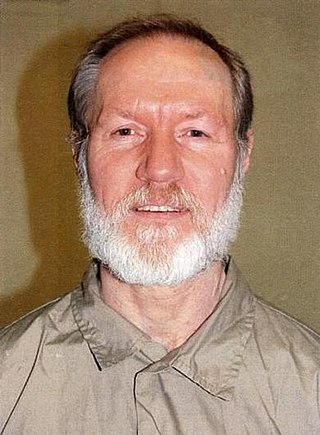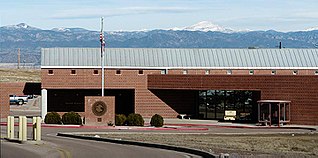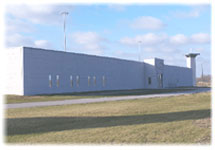
Capital punishment is a legal punishment under the criminal justice system of the United States federal government. It is the most serious punishment that could be imposed under federal law. The serious crimes that warrant this punishment include treason, espionage, murder, large-scale drug trafficking, or attempted murder of a witness, juror, or court officer in certain cases.

The United States Penitentiary, Leavenworth is a medium security U.S. penitentiary in northeast Kansas. It is operated by the Federal Bureau of Prisons, a division of the United States Department of Justice. It also includes a satellite federal prison camp (FPC) for minimum-security male offenders.

The Federal Bureau of Prisons (BOP) is a United States federal law enforcement agency within the U.S. Department of Justice that operates U.S. federal prisons and is responsible for the care, custody, and control of federal prisoners.

The United States Penitentiary, Administrative Maximum Facility, commonly known as ADX Florence or Supermax, is an American federal prison in Fremont County near Florence, Colorado, operated by the Federal Bureau of Prisons, a division of the United States Department of Justice. ADX Florence, constructed in 1994 and opened one year later, is classed as a supermax or "control unit" prison, that provides a higher, more controlled level of custody than a maximum security prison. ADX Florence forms part of the Federal Correctional Complex, Florence, which is situated on 49 acres of land and houses different facilities with varying degrees of security, including the adjacent United States Penitentiary, Florence High.

A super-maximum security (supermax) or administrative maximum (ADX) prison is a "control-unit" prison, or a unit within prisons, which represents the most secure level of custody in the prison systems of certain countries.

The Federal Correctional Institution, Thomson, formerly United States Penitentiary, Thomson and Thomson Correctional Center, is a low-security federal prison located in Thomson, Illinois. It has an area of about 146 acres (59 ha) and comprises 15 buildings. The facility is enclosed by a 15-foot (4.6 m), 7000 volt electric fence surrounded by an additional 12-foot (3.7 m) exterior fence covered with razor wire. Thomson has eight cellhouses with a rated capacity of 2,100 beds—1,900 high-security SMU beds and 200 minimum-security beds at the onsite camp—and according to BOP officials, the potential to use some of its high-security rated capacity to house up to 400 ADX inmates. From its completion in 2001 to 2006, it remained empty. By 2009, only the minimum-security section housed prisoners.

The United States Penitentiary, Coleman I and II are high-security United States federal prisons for male inmates in Florida. It is part of the Coleman Federal Correctional Complex and is operated by the Federal Bureau of Prisons, a division of the United States Department of Justice. USP Coleman I was opened in 2001, and in 2004 Clark Construction completed a 555,000-square-foot (51,600 m2) additional component for USP Coleman II.

Thomas Edward Silverstein was an American criminal who spent the last 42 years of his life in prison after being convicted of four separate murders while imprisoned for armed robbery, one of which was overturned. Silverstein spent the last 36 years of his life in solitary confinement for killing corrections officer Merle Clutts at the Marion Penitentiary in Illinois. Prison authorities described him as a brutal killer and a former leader of the Aryan Brotherhood prison gang. Silverstein maintained that the dehumanizing conditions inside the prison system contributed to the three murders he committed. He was held "in a specially designed cell" in what is called "Range 13" at ADX Florence federal penitentiary in Colorado. He was the longest-held prisoner in solitary confinement within the Bureau of Prisons at the time of his death. Correctional officers refused to talk to Silverstein out of respect for Clutts.

The United States Penitentiary, Lewisburg is a medium-security United States federal prison in Pennsylvania for male inmates. It is operated by the Federal Bureau of Prisons, a division of the United States Department of Justice. An adjacent satellite prison camp houses minimum-security male offenders.

The United States Penitentiary, Florence High is a high-security United States federal prison for male inmates in Colorado. It is operated by the Federal Bureau of Prisons, a division of the United States Department of Justice. USP Florence High is part of the Federal Correctional Complex, Florence, which is situated on 49 acres (20 ha) of land and houses different facilities with varying degrees of security. It is named "Florence High" in order to differentiate it from the United States Penitentiary, Florence ADMAX, the federal supermax prison located in the same complex.

The Federal Correctional Complex, Terre Haute is a United States federal prison complex for male inmates in Indiana; much of the complex grounds is in Terre Haute, though portions are in unincorporated Vigo County. It is operated by the Federal Bureau of Prisons, a division of the United States Department of Justice, and consists of two facilities:
David Paul Hammer was an American federal prisoner serving life without possibility of parole. He was sentenced to death on November 4, 1998 for the murder of his cell mate, Andrew Marti. Hammer's federal conviction was vacated in 2005 for the government's Brady violation. After 16 years in isolation on federal death row isolation at Terre Haute prison in Indiana, in 2014 the court resentenced him to life without parole. He was serving his sentence at the ADX Florence, Colorado until his death at Terre Haute in 2019.

The Federal Correctional Institution, Terre Haute is a medium-security United States federal prison for male inmates in Indiana. It is part of the Federal Correctional Complex, Terre Haute and is operated by the Federal Bureau of Prisons, a division of the United States Department of Justice. The facility also has an adjacent satellite prison camp for minimum-security male offenders.
Death row, also known as condemned row, is a place in a prison that houses inmates awaiting execution after being convicted of a capital crime and sentenced to death. The term is also used figuratively to describe the state of awaiting execution, even in places where no special facility or separate unit for condemned inmates exists. In the United States, after an individual is found guilty of a capital offense in states where execution is a legal penalty, the judge will give the jury the option of imposing a death sentence or life imprisonment without the possibility of parole. It is then up to the jury to decide whether to give the death sentence; this usually has to be a unanimous decision. If the jury agrees on death, the defendant will remain on death row during appeal and habeas corpus procedures, which may continue for several decades.

The United States Penitentiary, Beaumont is a high security United States federal prison for male inmates in unincorporated Jefferson County, Texas. It is part of the Federal Correctional Complex, Beaumont and is operated by the Federal Bureau of Prisons, a division of the United States Department of Justice.
A communications management unit (CMU) is a type of self-contained group within a facility in the United States Federal Bureau of Prisons that severely restricts, manages and monitors all outside communication of inmates in the unit.

The Federal Correctional Complex, Coleman is a United States federal prison complex for male inmates in unincorporated Sumter County, Florida, near Wildwood. It is operated by the Federal Bureau of Prisons (BOP), a division of the United States Department of Justice.

The United States Penitentiary, Victorville is a high-security United States federal prison for male inmates in California. It is part of the Federal Correctional Complex, Victorville and is operated by the Federal Bureau of Prisons, a division of the United States Department of Justice.
















